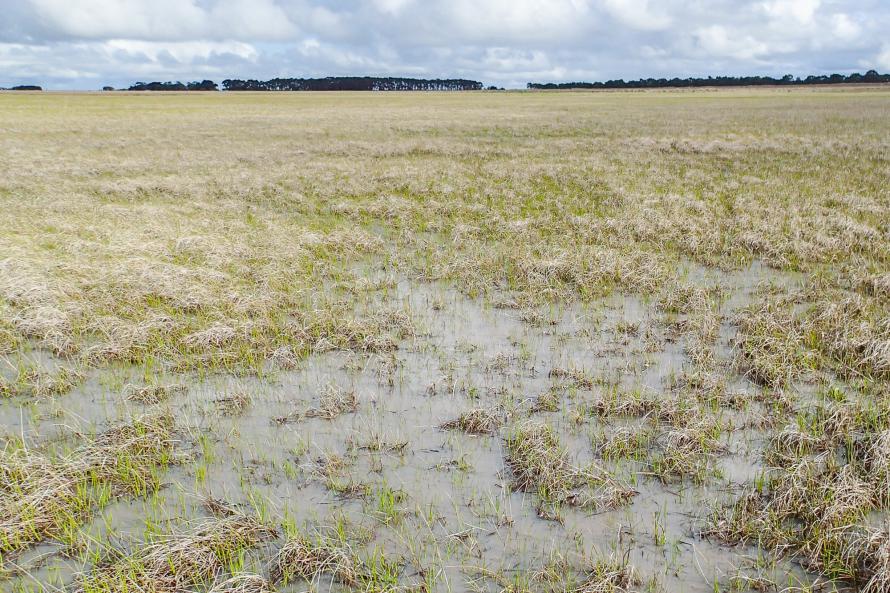

Mortlake Common Flora Reserve contains one of the largest remnants of the nationally listed critically endangered Natural Temperate Grassland of the Victorian Volcanic Plains. The reserve consists almost entirely of grassland, merging into a large (32 ha) seasonal wetland in the centre of the reserve. A shallow drain has been dug from the wetland, connecting it to Blind Creek, which enters the reserve on the eastern boundary and exits on the southern boundary. The reserve supports a high diversity of flora species in comparison to other large grassland remnants, including some large populations of threatened species, including the Western Gaping Leek Orchid, Basalt Leek-orchid, Plains Yam-daisy and Arching Flax-lily.
On Connewarren Lane, approximately 3 km west of the Mortlake township and approximately 150 km west of Geelong
Call Parks Victoria on 13 1963
Settlement of the area dates from the late 1830s, with land used mainly for grazing. Growth was minimal until the 1850s when the township of Mortlake and several smaller villages were established. Expansion continued in the 1880s and early 1890s, aided by the construction of the railway line. Significant development occurred during the interwar period and the immediate post-war years, aided by the soldier settlement scheme. The primary land use around the reserve has been dryland pasture and other primary production. The reserve was regularly grazed in the past by landholders without large land holdings, most likely set stock with low numbers. Shire documents from 1979 indicate that on average 130 cattle were kept on the Mortlake Common along with 6-10 horses. Upon recognition for its significant representation of threatened ecological communities, the Common was gazetted as a Preservation of Native Plants Reserve and management responsibility was transferred to Parks Victoria in 1997. While licensed grazing ceased in 1993, an agreement with a local stock agent kept sheep on Mortlake Common until 2007, with the sheep generally removed before the autumn break and not returned until the arrival of dry conditions around late January. Short, intense pulse grazing was also used as a technique for reducing biomass. No grazing has taken place since 2007. Since then, fire has been the main tool to manage biomass, with burns in early 2008, 2009 and 2012. Other recent conservation efforts have included control of gorse and grassy weeds, grassy biomass monitoring and monitoring of threatened orchid populations, carried out by Nature Glenelg Trust through a grant from DELWP.
The Mortlake Common Flora Reserve represents one of the largest and most herb-rich grasslands within the Western Volcanic Plains region. The large grassy wetland helps to support a high diversity of grassland species, including a number of rare and threatened species. These include the only known population of the Western Gaping Leek-orchid (Prasophyllum sp. aff. correctum), and a population of the state-listed (Flora and Fauna Guarantee Act 1988) Basalt Leek-orchid (Prasophyllum viretrum).
The large grassy wetland that supports a diverse range of aquatic and semi-aquatic flora. When the wetland is holding water, look for Latham’s Snipe and nesting Brolgas, and listen for the call of the Growling Grass Frog.
Continuing gorse and weedy grass control, control of spiny rush in Blind Creek, and implementing controlled burns for biomass reduction. Hydrological restoration of the wetland has been proposed, by blocking a shallow drain that runs south-east from the wetland to Blind Creek.
Acacia melanoxylon, Acaena echinata, Aira spp., Aira elegantissima, Amphibromus neesii, Amphibromus nervosus, Anthemis arvensis, Anthosachne scabra, Anthoxanthum odoratum, Arthropodium strictum, Austrostipa pubinodis, Asperula conferta, Avena barbata, Avena fatua, Baumea arthrophylla, Bossiaea prostrata, Briza maxima, Briza minor, Bromus hordeaceus subsp. hordeaceus, Caesia calliantha, Calocephalus lacteus, Carex breviculmis, Carex inversa, Centaurium erythraea, Centaurium tenuiflorum, Cirsium vulgare, Convolvulus angustissimus, Convolvulus erubescens, Coronidium gunnianum, Dactylis glomerata, Daucus glochidiatus, Deyeuxia quadriseta, Deyeuxia spp., Dianella admixta, Dianella longifolia, Dichelachne crinita, Eleocharis acuta, Eleocharis pusilla, Elymus scaber, Epilobium billardierianum subsp. intermedium, Epilobium ciliatum, Eragrostis capillaris, Eryngium ovinum, Eryngium vesiculosum, Eucalyptus camaldulensis, Euchiton involucratus, Festuca arundinacea, Glyceria australis, Gonocarpus tetragynus, Haloragis aspera, Haloragis heterophylla, Helichrysum sp. aff. rutidolepis, Helminthotheca echioides, Hemarthria uncinata, Holcus lanatus, Hypochaeris radicata, Isolepis fluitans, Isolepis levynsiana, Isolepis marginata, Juncus acuta, Juncus australis, Juncus bufonius, Juncus capitatus, Juncus holoschoenus, Juncus subsecundus, Lachnagrostis filiformis, Lactuca saligna, Leontodon taraxacoides subsp. taraxacoides, Leptorhynchos squamatus, Leptorhynchos tenuifolius, Linum marginale, Lobelia pratioides, Lolium perenne, Lomandra nana, Lycium ferocissimum, Lythrum hyssopifolia, Microlaena stipoides, Microseris scapigera, Microtis unifolia, Oxalis exilis, Oxalis perennans, Ozothamnus ferrugineus, Parentucellia viscosa, Pentapogon quadrifidus, Phalaris aquatica, Phragmites australis, Pimelea curviflora, Plantago coronopus, Plantago gaudichaudii, Plantago lanceolata, Poa labillardierei, Prasophyllum sp. aff. correctum, Prasophyllum viretrum, Romulea rosea, Rumex brownii, Rumex dumosus, Rytidosperma caespitosum, Rytidosperma duttonianum, Rytidosperma laevis, Rytidosperma setacea, Schoenus apogon, Schoenus nitens, Senecio biserratus, Selliera radicans, Sisyrinchium iridifolium, Solenogyne dominii, Sonchus asper, Sonchus oleraceus, Stellaria angustifolia, Thelymitra pauciflora, Themeda triandra, Trifolium spp., Triglochin procera, Triglochin striata, Vulpia bromoides
House Mouse, Lowland Copperhead, Common Eastern Froglet, Growling Grass Frog, Latham’s Snipe, Southern Brown Tree Frog, Spotted Marsh Frog, Tussock Skink, Australasian Pipit, Australian Magpie, Australian Raven, Brolga, Eurasian Skylark, Long-billed Corella, Swamp Harrier, Wedge-tailed Eagle, Whiskered Tern, Willie Wagtail, Hairy Burrowing Crayfish